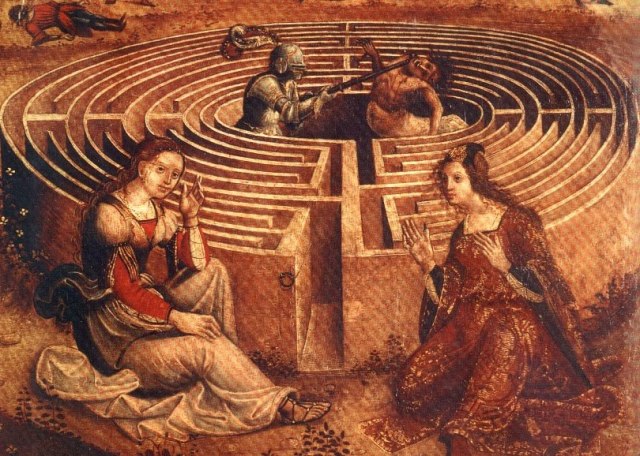 Lughnasadh has aspects of the death-rebirth process. The fertility of spring is coming to full realization with the beginning harvest. The light half of the year is moving toward darkness but we know that life will be reborn again; this is a time for celebration and gratitude…
Lughnasadh has aspects of the death-rebirth process. The fertility of spring is coming to full realization with the beginning harvest. The light half of the year is moving toward darkness but we know that life will be reborn again; this is a time for celebration and gratitude…
As a contemplative practice, the construction of land art is an embodiment of sacred space. It is a physical manifestation and acknowledgement of the awareness of the reciprocal relationship between the human soul, place, earth, and the universe…
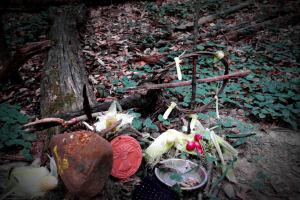 Though traditionally celebrated on August 1, we had our Lughnasadh celebration last Sunday, closer to the astronomical date this year, which was the 9th. After brief introductions and chats on the wheel of the year, we went on a contemplative nature walk to commune with the spirits of Danu. (During this walk we had an encounter with a blue heron taking flight out of the stream which we were walking by and flying directly overhead. This was significant as we had also been discussing the symbolism of cranes and herons as threshold creatures and messengers from the gods). After the walk we arrived at Visionsong and set up an altar space and did a contemplative place bonding exercise. We followed this by the construction of a stone labyrinth in the central area. We will probably continue to add stones to the labyrinth to make it ‘fuller’, but we got a good start on the outline (pics below). After this, we had a ‘farmer’s market potluck’ feast of corn chowder, peppers, radishes, and apple pie.
Though traditionally celebrated on August 1, we had our Lughnasadh celebration last Sunday, closer to the astronomical date this year, which was the 9th. After brief introductions and chats on the wheel of the year, we went on a contemplative nature walk to commune with the spirits of Danu. (During this walk we had an encounter with a blue heron taking flight out of the stream which we were walking by and flying directly overhead. This was significant as we had also been discussing the symbolism of cranes and herons as threshold creatures and messengers from the gods). After the walk we arrived at Visionsong and set up an altar space and did a contemplative place bonding exercise. We followed this by the construction of a stone labyrinth in the central area. We will probably continue to add stones to the labyrinth to make it ‘fuller’, but we got a good start on the outline (pics below). After this, we had a ‘farmer’s market potluck’ feast of corn chowder, peppers, radishes, and apple pie.
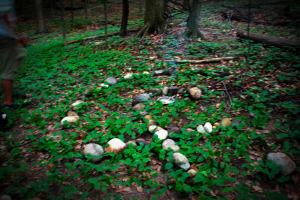 As a contemplative practice, the construction of land art is an embodiment of sacred space. It is a physical manifestation and acknowledgement of the awareness of the reciprocal relationship between the human soul, place, earth, and the universe. The building of the labyrinth is two-fold act of creation – inner and outer. We build in the outer, feeling the stones and the earth, experiencing the warmth of summer, and witnessing the unification of place with ourselves and each other. We build in the inner as we then walk the labyrinth to the center, through the maze of life, emerging in the middle which is symbolic of the Self. The Self is a Jungian archetype, emerging through the unification of consciousness and unconsciousness and is the embodiment of the psyche as a whole. The Self, according to Jung, is realized through the process of individuation, which in his view is the process of integrating one’s personality and holding the tension between the different psychic energies of the personal and collective. For Jung, the Self is symbolized by the circle (especially when divided in four quadrants), the square, or the mandala. Seen as a mandala, the labyrinth symbolizes all of the aspects of our psyche, the individuation process, and realization of self.
As a contemplative practice, the construction of land art is an embodiment of sacred space. It is a physical manifestation and acknowledgement of the awareness of the reciprocal relationship between the human soul, place, earth, and the universe. The building of the labyrinth is two-fold act of creation – inner and outer. We build in the outer, feeling the stones and the earth, experiencing the warmth of summer, and witnessing the unification of place with ourselves and each other. We build in the inner as we then walk the labyrinth to the center, through the maze of life, emerging in the middle which is symbolic of the Self. The Self is a Jungian archetype, emerging through the unification of consciousness and unconsciousness and is the embodiment of the psyche as a whole. The Self, according to Jung, is realized through the process of individuation, which in his view is the process of integrating one’s personality and holding the tension between the different psychic energies of the personal and collective. For Jung, the Self is symbolized by the circle (especially when divided in four quadrants), the square, or the mandala. Seen as a mandala, the labyrinth symbolizes all of the aspects of our psyche, the individuation process, and realization of self.
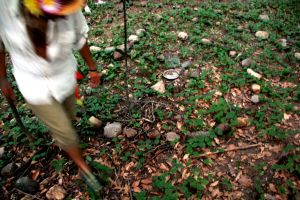 This is significant on Lughnasadh for we walked the labyrinth with the intention of moving closer not only to the center of our souls but also to the sacred space within which it is constructed. By coming closer to the center of the place, we are bridging from that place and moving toward the center of the grand ecology of the environment, universe, and spirit. This is the marriage in the name of Lugh – ecological individuation. Jung wrote that there are two centers of the self. The one is center of consciousness – the ego, whereas the center of the whole person (the soul) is the Self, which includes consciousness, the unconscious, and the ego. Within the grand ecology of the Visionsong labyrinth, the idea of Self takes on new dimensions – we are no longer a Self separate from the universe, we are a Self that is the earth and universe.
This is significant on Lughnasadh for we walked the labyrinth with the intention of moving closer not only to the center of our souls but also to the sacred space within which it is constructed. By coming closer to the center of the place, we are bridging from that place and moving toward the center of the grand ecology of the environment, universe, and spirit. This is the marriage in the name of Lugh – ecological individuation. Jung wrote that there are two centers of the self. The one is center of consciousness – the ego, whereas the center of the whole person (the soul) is the Self, which includes consciousness, the unconscious, and the ego. Within the grand ecology of the Visionsong labyrinth, the idea of Self takes on new dimensions – we are no longer a Self separate from the universe, we are a Self that is the earth and universe.
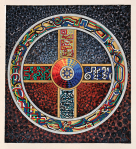 Lughnasadh has aspects of the death-rebirth process. The fertility of spring is coming to full realization with the beginning harvest; the light half of the year is moving toward darkness. But we know that life will be reborn again, and this is a time for celebration and gratitude. As we walk the labyrinth toward the center of ecological individuation, our old, limited self dies, and our new, larger self is born. Remembering this on the harvest festival of Lughnasadh is a way to express our gratitude, celebrate our unity, and re- awaken to the inherent oneness of humanity and the earth.
Lughnasadh has aspects of the death-rebirth process. The fertility of spring is coming to full realization with the beginning harvest; the light half of the year is moving toward darkness. But we know that life will be reborn again, and this is a time for celebration and gratitude. As we walk the labyrinth toward the center of ecological individuation, our old, limited self dies, and our new, larger self is born. Remembering this on the harvest festival of Lughnasadh is a way to express our gratitude, celebrate our unity, and re- awaken to the inherent oneness of humanity and the earth.
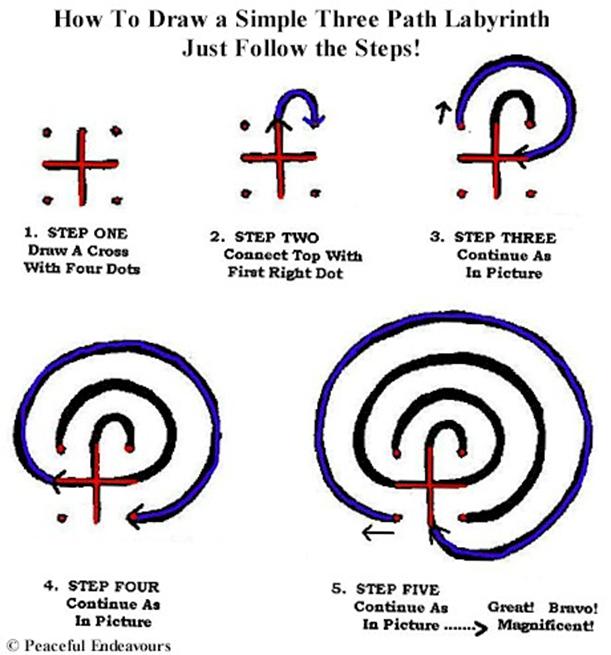

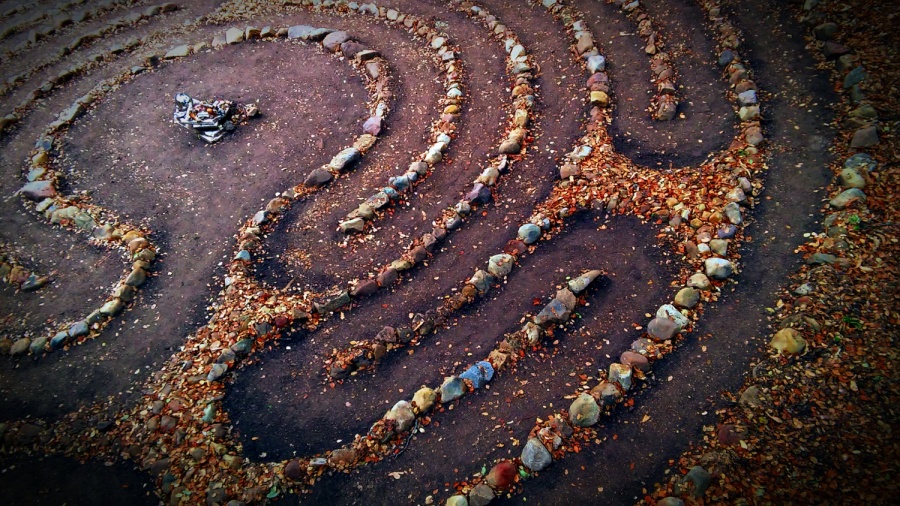
I especially enjoyed how you tied in Jungian theory to this experience. For the skeptical audience, I think it’s an important addition; for those who consider psychology less supernatural than spiritualism.
Did you experience any changes thereafter–the next day perhaps–indicative of a re-awakening or effect of contemplation that you’d like to share? I’m curious how your experience was affected post-ritual.
Excited to follow you!
Thanks, an interesting question…
Leaving a space like that is always kind of a ‘drop,’ but this was more of a gradual levelling off… It often takes some time to integrate and recapitulate. During the ritual (especially one with a task such as building a piece of land art, I discovered) it is more of a ‘swimming,’ experiential space. Though there was the feeling of numinosity, I did not necessarily pause to experience it during… it was just the ever present ‘backdrop.’ Coming out of that space was a leveling off, but there were no significant events or insights that really jumped out at me.
What did happen was a line of questioning opened up… in relation to the harvest festival, I began reflecting on what is going through the harvest or death/rebirth process in my life right now, and how that might be guiding me closer to the center of Self. There certainly have been many changes over the past few years, some significant, but mostly gradual ones that I have just kind of gone with… small changes here and there, minor adaptations, that more or less go unnoticed. After the Lughnasadh ritual, when I reflected on the ritual and the labyrinth, it became very clear that a harvest is taking place in my life. Over the past 3 years, much of my old life has ‘died’ (actually everything except my beloved border collie, Cara, and she isn’t going anywhere if I can help it :)); the harvest of my work over the past few years is taking place, and there will be a rebirth of sorts as I begin a M.A./Ph.D. program in depth psychology this fall.
So there were no ‘burning bushes’ after Lughnasadh, but I do think that the ritual was an external expression and acknowledgement of the process I have been on – inner, psychospiritual, and in the daily circumstances of life. The ritual, and your question, has helped me bring things a bit sharper into focus, and a container for some of the feelings around the changes I am going through has come into awareness.
Thank you for your elaborate and thoughtful reply.
I am left curious about something: do you mean “the center of Self” to denote a locus literally or metaphorically? It’s ties on themes of biology and Cartesian Dualism that I personally find material to this topic.
Thanks for your time!
Good point and big questions…
Please forgive my rather hasty choice of words, and for not engaging the Cartesian can-o-worms 🙂 Rather than ‘center of Self,’ I meant ‘Self as center’ in a Jungian sense, in a unified ecology with the conscious and unconscious, and with the wider universe in the form of the natural world.
Firstly, though, it might be helpful to place Descartes into the proper historical context. His work was not new or novel in any way – these questions go back, in the west, to the ancient Greek philosophers. Descartes engaged them from the perspective of his historical situation. He wrote in a period of the extreme turmoil and upheaval of worldviews of the reformation, counter-reformation, and thirty years war in which all the ‘authorities’ were telling a different story. Descartes’ project was thus to find something upon which all could agree, hence his method of doubt and the resulting epistemology that has marked western philosophy ever since. Though, arguably, this has been damaging and limiting, and poor Rene in his pajamas is often the whipping boy, his ideas did serve a useful purpose at the time. The danger arose in the inability to either ‘move on’ or to answer the questions he raised, which sent epistemologists of all stripes into a tizzy for several centuries. It is my feeling that this contributed to the loss of philosophy as a practice and way of a life and is a main reason for the perceived irrelevance of philosophy (indeed, all of the humanities) in our contemporary world.
In short, I feel that philosophy asks the question of what, which is important but does not lead to a realization of its ancient purpose of enabling a meaningful life. Western philosophy was a practice, a way of life, and sought truth mainly as a means of enabling this. Eastern philosophy seems to not have lost its way as much as western philosophy… an interesting contemporary take on this is found in the writings of Pierre Hadot.
I prefer a more Husserlian phenomenological approach to epistemology, and the ‘bracketing’ of whether or not something is true. A description of the processes and experiences will, I feel, bring us closer not only to a deeper understanding of the ‘what’ of human experience, but also to a better approach to the ‘how’ of that experience. A final philosophical or scientific determination of whether or not there is dualism, while certainly interesting, will not lead us to these desired goals. In fact, I think it is evident in our society that a one sided physical worldview leads to problems of overmedication, which suppresses ‘symptoms’ but does not nurture the psychospiritual maturation process. A phenomenological approach leads to truth without losing the ability to understand how that truth actually fits in to our real lives to enable a meaningful life for ourselves and others, including future generations. Though I don’t agree wholeheartedly with any of them, some contemporary thinkers on this matter include Hopp or Huemer. Though many will disagree, I actually think that epistemology, as an active inquiry, has served its purpose and should be allowed to go quietly into the night…. Remaining questions can be (and are being) taken up by philosophies of mind and language (though mind might be better left to science; the philosophy of language, when approached properly can be hugely relevant…)
Taking a step farther back from Descartes, the problem of dualism might raise questions as to whether or not the Jungian archetypes are really Platonic forms… While perhaps analogous, I think they can be quite clearly differentiated (and only a Platonist can see them as such), but that is a topic for a different discussion perhaps 🙂 At any rate, it has been my experience that the problem of dualism dissolves when engaging from the idea of Self as center. Viewing this as a mandala unifies and allows the acknowledgement of other aspects of the world that can either be viewed as ‘external’ or material distinct from the mind – or not – enabling the nurturing of a more holistic engagement with all aspects of our human experience in an inclusive and more meaningful way.
You could definitely see your skills in the work you write.
The arena hopes for more passionate writers such as you who aren’t afraid to
mention how they believe. All the time go after your heart.